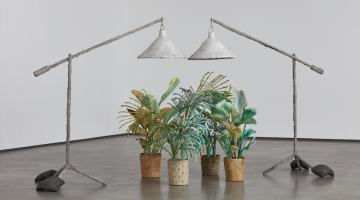When visiting Regen Projects in Los Angeles, you will encounter a collection of new sculptural works by Abraham Cruzvillegas, an artist originally from Mexico City. His work is a process of rediscovery of found materials from the outside urban environment. By investigating the cultural significance in objects and images, and their history within our culture, Cruzvillegas creates new dialogues for what would normally be discarded or useless. Rebar is a recurring material in Cruzvillegas’ sculptures and define the structure which all the found objects are displayed upon, and is an industrial material used for structural reasons when pouring concrete and can be considered the skeleton that keeps urbanized spaces in existence. Rebar is one of the most important material for a building’s foundation, which is interesting to think about when viewing Cruzvillegas’ work. The combination of internal materials of our buildings’ infrastructures and objects and images from the urban landscape develops a space for evaluation and refection of Cruzvillegas’ acquired readymades contained within the spacial constructs in each piece. Cruzvillegas process with rebar can also be looked at as an investigation in the quality of the line, discussed most within the realms of drawing and painting, and how he determines navigation within each piece with the composition and form that the line creates when traveling through the 3 dimensional space of the gallery.
–
Contributed by Gregory Ito

Installation view: Autodestrucción 1. Regen Projects, Los Angeles. November 3 - December 22, 2012. Courtesy of Regen Projects.

Abraham Cruzvillegas. Ils sont zazous (democratist & engaged). 2012. Rebar, fabric, feathers, chain, and meat. 35 x 135 x 30 inches (88.9 x 342.9 x 76.2 cm). Courtesy of Regen Projects.

Abraham Cruzvillegas. Vendredi 13 (affirmative, written & told). 2012. Rebar, fabric, chain, feathers and meat. 150 x 92 x 65 inches (381 x 233.7 x 165.1 cm). Courtesy of Regen Projects.

Abraham Cruzvillegas. Zah-Zuh-Zaz (joyful & warm). 2012. Rebar, chain, feathers, and meat. 150 x 82 x 51 inches (381 x 208.3 x 129.5 cm). Courtesy of Regen Projects.
Venue: Regen Projects, Los Angeles
Artist: Abraham Cruzvillegas
Exhibition Title: Autodestrucción
Exhibition Dates: November 3 – December 22, 2012
Website: http://www.regenprojects.com/current/#1
Press Release (Excerpt):
Regen Projects is pleased to announce the gallery’s representation of artist Abraham Cruzvillegas. Cruzvillegas was born in Mexico City in 1968, where he lives and works. Cruzvillegas’ practice deals with history and the construction of the self in reference to economic, social, political, and historical conditions. Employing various means to create open-ended strategies of production and reception, Cruzvillegas gives objects a new life and context, generating shifts in meaning and interpretation, meanwhile demonstrating how concepts and relationships can be constantly inverted and transformed. He explores economies of the makeshift, hand-made, and the recycled, and often incorporates site and elements of a particular location within the context of a work, exhibition, or project, creating a connection between Mexico City and the location in which the artist is working. His practice examines the way in which one constructs or reconstructs histories from information, illustrating how ideas are often a dialogic conflation of many people, places, and times. Improvisation and assemblage are core aspects of his practice, which is informed by, and connected to ideas of survival economics, labor economies, and the ready-made.
The exhibition’s predominantly sculptural works, adorned with found and constructed objects, are based on images and dress of the Parisian Zazou and Californian Zoot Suiters. Drawing source material and inspiration from the culture and music of the Zoot Suit, Zazou, and Pachuco movements, these underground modes of expression share a culture of resistance in which fashion and identity create and construct a temporary notion of the self through style, costume, and ideology. Attire was a way to embody resistance and to defy conformity. Social inequalities and rebellion were marked by way of dress, and once these ideologies failed, the style faded away as the protagonists changed and reverted to some other reality.


